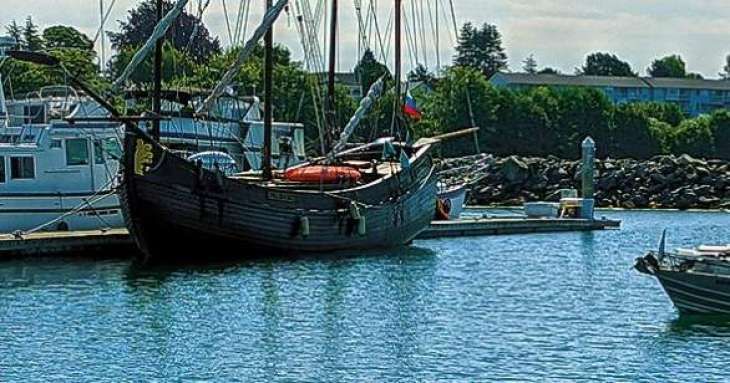A crew of Russian and US voyagers who are traveling around the world on the Pilgrim a replica of the 18th century wooden Pomor boat completed another stage of their trip by sailing from Alaska to Russia's Kamchatka Peninsula, the team captain Sergey Sinelnik told Sputnik
WASHINGTON (Pakistan Point News / Sputnik - 01st November, 2022) A crew of Russian and US voyagers who are traveling around the world on the Pilgrim a replica of the 18th century wooden Pomor boat completed another stage of their trip by sailing from Alaska to Russia's Kamchatka Peninsula, the team captain Sergey Sinelnik told Sputnik.
"This year, we covered a distance of more than 2,000 miles from the US city of Homer in Alaska to the Russian city of Petropavlovsk-Kamchatskiy," Sinelnik said.
The 40-foot sailboat Pilgrim started the voyage around the world in 2017 from the city of Petrozavodsk in Russia's Karelia region. On the way to the United States, the vessel visited 12 countries during its trip around Europe, and then Cape Verde, the Canary and Caribbean islands. While in North America, Pilgrim navigated through the Great Lakes and sailed along Canada's West Coast.
The boat spent the winter in Alaska while the crew went home. Sinelnik hoped to start the trip this year as early as possible, but issues related to the current geopolitical situation forced him to change his initial plans.
"My US visa was about to expire so I wanted to fly to the United States early. However, when my Aeroflot flight was canceled, I decided to stay at home with my family for some time," he said.
In April, Sinelnik finally came to the United States, where he met his chief mate Alexii Volchok, a Russian-American from Florida. Both men drove across the country to Seattle and then flew to Alaska.
With this trip, Sinelnik fulfilled his long-term dream to cross on foot the Mojave Desert and Death Valley in California.
Sinelnik was surprised that even in the desert it is rare to find an area without civilization. Almost everywhere one can see ranches, albeit abandoned, he said.
"You can still find places where you walk tens of kilometers and do not meet a single person," Sinelnik said. "There are mountains from the west and from the east and you walk along the salt flats where there is a danger that one can drown."
Sinelnik pointed out that he understood why it is called Death Valley.
"I walked over these bumps, they are not high, but there are so many of them that you can tear all your shoes. So, you walk along those bumps that are smaller, or you choose places where the water washed them out a little," he said.
After their desert adventure, Sinelnik and Volchok flew to Alaska and began preparing the Pilgrim for the next part of the maritime trip. They covered the wood with linseed oil, replaced broken sensors, mended sails, changed sheets and rigging and removed any mold inside the boat hull.
"The Bering Sea is one of the harshest seas in the world and the route from the Alaska Peninsula through the Aleut and the Commander Islands to Kamchatka is among the 14 darkest places in the world. Now, after sailing this route, I can fully agree with that," he said.
Sinelnik noted that only few vessels from Russia sailed this route between the 1990s and 2010s, and two of them had sunk. The route is known for strong winds and heavy streams, he said.
Sailing in such "dark corridors" may be dangerous even in relatively calm weather, according to Sinelnik. An additional challenge is that this area is uninhabited.
"We sailed 770 miles from Adak Island in Alaska to Russia's Commander Islands and did not see even a single inhabited island," Sinelnik said.
The crew was unable to replenish gas supplies on the island of Adak the last inhabited island on the way to Russia and did not meet a single person after that point, he said, adding that they had to restrict the use of their heater by using it occasionally to dry clothes.
"People are already used to the fact that everyone has internet, WhatsApp, Telegram, and here you fall out of all this for three weeks, not just somewhere on warm islands but in the most severe places on the planet," Sinelnik said.
Russian border guards allowed the Pilgrim to enter the country via the Commander Islands although it should have gone to Chukotka or directly to Petropavlovsk-Kamchatskiy, where it is impossible to sail without encountering strong headwinds.
Having completed the trip, Sinelnik is already thinking about the next trip and dreaming of more desert voyages.
"My brother Alexander and I want to return to the Namib Desert and cross the Kalahari once again. We have already assembled a team, but let's see how it will work out," he said.
Speaking of his future plans to sail on the Pilgrim, Sinelnik said he does not want to look too far ahead.
"Probably it will be the Northern Sea route, but most likely we will go along the Kuril Islands to Sakhalin and Vladivostok," he said.




